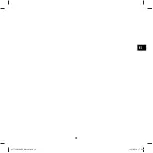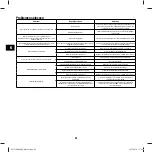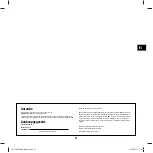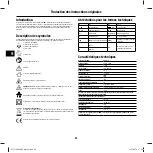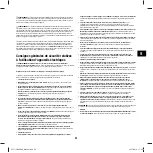
8
GB
k) Work surfaces and sandpaper can become very hot during use. If there is evidence of burning
(smoke or ash) from the work surface, stop and allow the material to cool.
DO NOT touch work
surface or sandpaper until they have had time to cool
l) DO NOT touch the moving sandpaper
m) ALWAYS switch off before you put the sander down
n) DO NOT use for wet sanding.
Liquids entering the motor housing can cause severe electric shocks
o) ALWAYS unplug the sander from the mains power supply before changing or replacing sandpaper
p) Even when this tool is used as prescribed it is not possible to eliminate all residual risk factors.
If
you are in any doubt as to safe use of this tool, do not use it
Product Familiarisation
1. Front Grip
2. Mode Selector Switch
3. Auxiliary Handle Installation Hole
4. ON/OFF Switch
5. Main Handle
6. Speed Control Dial
7. Dust Extraction Port
8. Hook and Loop Backing Pad
9. Sanding Disc
10. Auxiliary Handle
Accessories (not shown):
• 3 x Hook and Loop Sanding Discs (1x 100grit, 1 x 150grit, 1 x 240grit)
• 1 x Screwdriver
• 1 x Woollen polishing bonnet
• 1 x Polishing foam
Intended Use
Mains-powered rotating dual-mode sander and polisher. Can be used on wood, plastics, metals, composite
materials, paint/varnish, fillers and similar products, using compatible accessories such as sanding discs and
polishing sponges/bonnets.
WARNING:
This tool may only be used for dry sanding applications; it is unsuitable for wet sanding.
Unpacking Your Tool
• Carefully unpack and inspect your tool. Fully familiarise yourself with all its features and functions
• Ensure that all parts of the tool are present and in good condition. If any parts are missing or damaged,
have such parts replaced before attempting to use this tool
Before Use
Fitting a Hook & Loop Backing Pad
WARNING:
Always disconnect from the power supply before removing or attaching the Hook and Loop
Backing Pad.
Note:
This sander is supplied with its regular Hook and Loop Backing Pad (8) factory pre-installed. It
may, however, become necessary to remove and replace the Hook and Loop Backing Pad, in order to fit
replacements, perform maintenance or to clean the device thoroughly.
1. Switch the Mode Selector Switch (2) to fixed orbit mode (see ‘Selecting Sanding Mode’)
2. Remove the Sanding Disc (9) (if fitted) by peeling it from the Hook and Loop Backing Pad
3. Use a suitable screwdriver to remove the 4 x screws then remove Hook and Loop Backing Pad from the
device
4. Clean Hook and Loop Backing Pad (if required) and replace back on to the device, or install replacement
Hook and Loop Backing Pad (if required)
5. Screw in 4 x screws, but do not over-tighten
6. Apply a Sanding Disc and continue work
IMPORTANT:
Be careful not to damage the screws during the removal or re-application process. If you have
any problems, consult a qualified GMC technician.
Selecting the right grade of Sanding Disc
• Sanding discs are available in a variety of different grades: coarse (60 grit), medium (120 grit),
and fine (240 grit)
• Use a coarse grit to sand down rough finishes, medium grit to smooth the work, and fine grit to finish off
• Always use good quality sanding discs to maximise the quality of the finished task
• It is advisable to do a trial run on a scrap piece of material to determine the optimum grade of sanding disc
for a particular job. If there are still marks on your work after sanding, try either going back to a coarser
grade and sanding the marks out before recommencing with the original choice of grit, or try using a new
sanding disc to eliminate the unwanted marks before going on to a finer grit and finishing the job
Fitting a Sanding Disc
WARNING:
Always ensure that the tool is switched off and the plug is removed from the power supply,
before fitting or removing sanding discs.
Note:
DO NOT continue to use worn, torn or heavily clogged sanding discs. Ensure foreign objects, such as
nails and screws, are removed from the workpiece before starting to sand.
WARNING:
DO NOT use a sanding disc on wood that has previously been used on metal. This may cause
scouring on the wooden surface.
• In order for the dust extraction system to function (if connected), this sander must only be used with
punched sanding discs with holes that match the holes in the Hook and Loop Backing Pad (8)
(Images A and B):
1. Remove the old Sanding Disc (9) (if fitted) by peeling it away from the Hook and Loop Backing Pad
2. Remove any dust or debris from the Hook and Loop Backing Pad
3. Match the holes in a suitable Sanding Disc with the holes in the Hook and Loop Backing Pad
4. Press the Sanding Disc on to the pad to attach it
Note:
To maximise the life of the Hook and Loop base, peel the Sanding Disc off slowly rather than rapidly
removing it to avoid damage to the Hook and Loop system.
WARNING:
Take care to regularly clean out the build-up of dust on the base underneath the Sanding Disc
and not to let the disc wear completely down before replacing it. Failure to observe these two precautionary
measures can lead to damage to the hooks and loops on the base, and the Sanding Disc will not attach
properly.
Installing the Auxiliary Handle
Note:
The Auxiliary Handle (10) can be installed on either side of the Random Orbital Sander. There is an
Auxiliary Handle Installation Hole (3) on either side for left or right-handed use.
• Screw the Auxiliary Handle into one of the Auxiliary Handle Installation Holes on one side of the
sander (Image C)
Dust extraction
Note:
This sander is designed to be connected to a household vacuum cleaner hose or workshop dust
extraction system. This is the preferred and most effective method of dust extraction.
WARNING:
ALWAYS ensure that the tool is switched off and disconnected from the power supply before
attaching or removing any accessories.
WARNING
: If the sanding dust contains harmful substances, such as particles from old paint, varnish,
surface coatings, etc. ALWAYS connect the sander to a suitable vacuum cleaner or workshop dust extraction
system. Always dispose of harmful dust according to laws and regulations.
WARNING
: Take special care to guard against harmful and toxic dusts when sanding lead-based painted
surfaces, woods and metals, particularly if you are unsure about the exact substances involved. All persons
entering the work area must wear a mask specially designed for protection against the toxic dust and fumes
involved. NEVER allow children and pregnant women to enter the work area. DO NOT eat, drink or smoke in
the work area.
• Push a suitable vacuum hose on to the Dust Extraction Port (7), which is designed to fit a 32mm diameter
hose
437712/932890_Manual.indd 8
11/07/2019 17:54
Summary of Contents for GGOS150
Page 2: ...1 2 3 4 5 6 7 10 9 8 437712 932890_Manual indd 2 11 07 2019 17 54 ...
Page 3: ...A B C D E 437712 932890_Manual indd 3 11 07 2019 17 54 ...
Page 4: ...437712 932890_Manual indd 4 11 07 2019 17 54 ...
Page 11: ...GB 11 437712 932890_Manual indd 11 11 07 2019 17 54 ...
Page 19: ...NL 19 437712 932890_Manual indd 19 11 07 2019 17 54 ...
Page 43: ...IT 43 437712 932890_Manual indd 43 11 07 2019 17 54 ...
Page 51: ...ES 51 437712 932890_Manual indd 51 11 07 2019 17 54 ...
Page 62: ...62 437712 932890_Manual indd 62 11 07 2019 17 54 ...



















